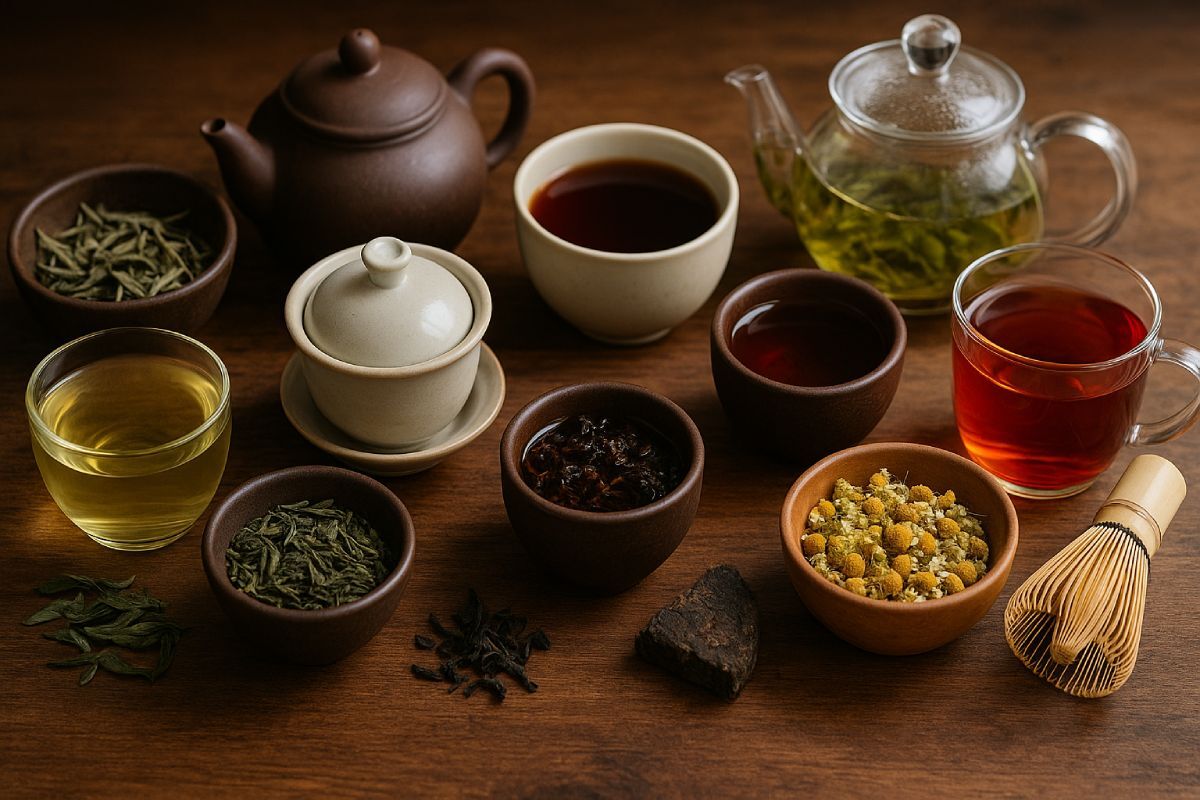
Did you know that every cup of true tea you've ever enjoyed—whether it was a delicate white tea, a grassy green tea, a complex oolong, or a robust black tea—all originate from the leaves of a single, remarkable plant? It's true. Every one of these distinct teas comes from the Camellia sinensis plant. The vast world of difference between them comes not from the plant itself, but from the art and science of how the leaves are processed after they are harvested.
Beyond this family of "true teas" lies the equally diverse world of herbal infusions, or tisanes, which are made from a wide array of herbs, spices, flowers, and roots. This guide will walk you through the major categories of tea, exploring how a single leaf can produce a spectrum of flavors and introducing you to the most popular herbal alternatives.
The Spectrum of True Teas: The Role of Oxidation
The key to understanding the difference between the main types of tea is oxidation. This is a natural chemical process where the enzymes in the tea leaves react with oxygen, causing the leaves to darken and their flavor profile to change. The level of oxidation is carefully controlled by the tea master to create a specific type of tea.
White Tea (Least Oxidized)
Considered the most delicate and least processed of all teas, white tea is made from the youngest, unopened buds of the tea plant, which are often covered in fine, silvery-white hairs. The buds are simply harvested and withered to dry, undergoing minimal oxidation.
- Flavor Profile: Subtle, delicate, and often sweet, with floral, fruity, and honey-like notes.
- Popular Varieties: Silver Needle (Bai Hao Yinzhen), White Peony (Bai Mudan).
Green Tea (Unoxidized)
To create green tea, the leaves are harvested and quickly heated—either by pan-firing (common in China) or steaming (common in Japan)—to halt the oxidation process before it can begin. This preserves the leaves' vibrant green color and fresh, grassy character.
- Flavor Profile: Varies greatly, from savory and oceanic (steamed) to nutty and sweet (pan-fired). Common notes include fresh grass, roasted vegetables, and toasted nuts.
- Popular Varieties: Sencha, Matcha, Dragon Well (Longjing), Gunpowder.
Oolong Tea (Partially Oxidized)
Oolong is the most diverse and complex category of tea, sitting between green and black tea on the oxidation spectrum. The leaves are withered, shaken, and allowed to partially oxidize. This process can be stopped at anywhere from 10% to 80% oxidation, resulting in a massive range of flavors.
- Flavor Profile: Can range from light, floral, and creamy (less oxidized) to dark, roasty, and fruity (more oxidized).
- Popular Varieties: Iron Goddess of Mercy (Tie Guan Yin), Big Red Robe (Da Hong Pao).
Black Tea (Fully Oxidized)
Black tea is the most popular type of tea in the Western world. To produce it, the leaves are harvested, withered, rolled to break down their cell walls, and then allowed to fully oxidize. This turns the leaves a dark brownish-black and creates deep, robust, and malty flavors.
- Flavor Profile: Bold, brisk, and full-bodied with notes of malt, honey, fruit, and spice.
- Popular Varieties: Assam, Darjeeling, Keemun, Earl Grey, English Breakfast.
Pu-erh Tea (Post-Fermented)
Pu-erh is a unique category of tea from Yunnan, China, that undergoes a secondary fermentation and aging process after the leaves are dried. Like fine wine, Pu-erh can improve with age, developing a rich, earthy complexity over decades.
- Flavor Profile: Deep, earthy, and smooth, with notes of damp soil, wood, and mushroom.
Beyond the Leaf: A Guide to Herbal Infusions (Tisanes)
Anything brewed like tea that does not come from the Camellia sinensis plant is technically called an herbal infusion or "tisane." Most of these are naturally caffeine-free.
- Rooibos (Red Tea): Made from a South African shrub, rooibos is naturally sweet, nutty, and caffeine-free.
- Herbal Teas: This broad category includes infusions made from flowers (chamomile, hibiscus), leaves (peppermint, lemongrass), and roots (ginger, turmeric).
- Yerba Mate: A traditional South American infusion that is known for its earthy flavor and high caffeine content (from a compound called mateine).
- Chai: Chai is not a type of tea, but a style of preparation. It is a spiced milk tea, traditionally made with a strong black tea base and a blend of aromatic spices like cardamom, cinnamon, ginger, and cloves.
Frequently Asked Questions About Tea Types
What is the main difference between black tea and green tea?
The main difference is oxidation. Green tea leaves are heated immediately after harvesting to prevent oxidation, preserving their green color and fresh, grassy flavor. Black tea leaves are rolled and allowed to fully oxidize, which turns them dark and creates a deeper, maltier, and more robust flavor profile.
Which type of tea has the most caffeine?
Generally, black tea contains the most caffeine, followed by oolong, green, and white tea. However, the caffeine content can vary greatly based on the specific plant varietal, processing, and brewing method. Yerba Mate, an herbal infusion, is also very high in caffeine.
What are herbal teas? Are they really "tea"?
Herbal teas, more accurately called "tisanes," are beverages made by infusing herbs, spices, flowers, or roots in hot water. Since they do not contain leaves from the Camellia sinensis plant, they are not technically "true teas" and are almost always caffeine-free.
What is oolong tea?
Oolong tea is a partially oxidized tea that sits between green tea (unoxidized) and black tea (fully oxidized). Its incredible diversity in flavor—from light and floral to dark and roasty—comes from the tea master's control over the level of oxidation.
